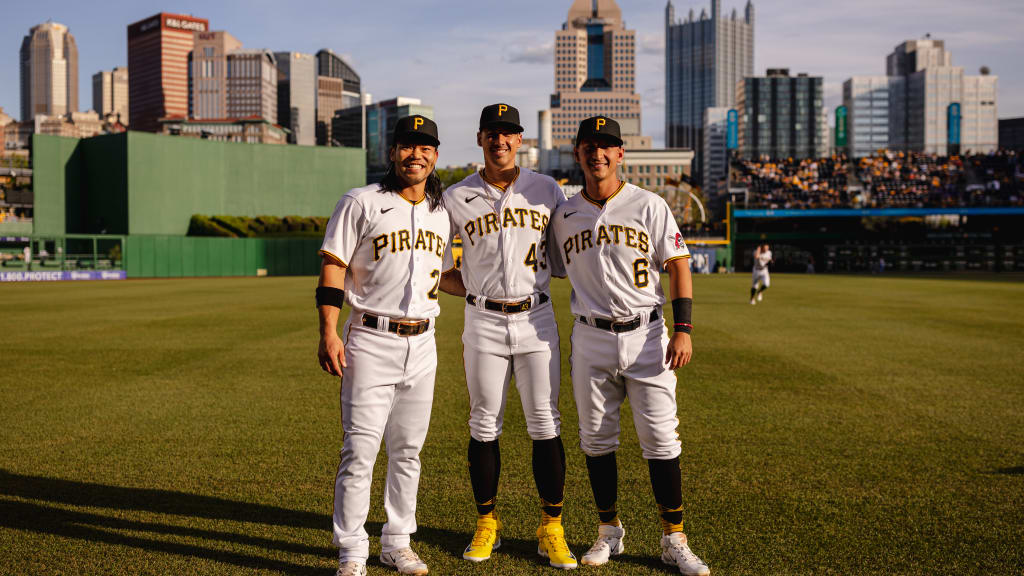PITTSBURGH -- On April 21, Connor Joe, Mark Mathias and Robert Stephenson combined to, in the words of Mathias, “put on for the community.”
Joe, who identifies as Chinese American, reached base four times and scored twice. Mathias, who also identifies as Chinese American, recorded a two-run single. Stephenson, who identifies as Filipino American, pitched a scoreless seventh inning, recording his third hold.
On this night, three Asian American men donning the black and gold played roles in a 4-2 Pirates win -- a win that served as a testament to the increasing influence of Asian Americans not just in baseball, but sports as a whole.
“It’s not something I would have ever really realized, but to hear it, it’s really cool,” Joe said.
Joe, Mathias and Stephenson are among the many Asian Americans who have played in the Majors this season, a list that includes names such as Christian Yelich, Lars Nootbaar, Anthony Volpe, Travis d’Arnaud, Kolten Wong and Steven Kwan.
Asian Americans have historically comprised a small fraction of Major League Baseball’s player pool, but in recent years, Asian Americans have carved out more space as prominent figures in the game. As evidenced with the Pirates, the presence of multiple Asian American players on the same team is becoming increasingly common.
“There aren’t too many Asian Americans in baseball, so being one of the few is special,” Mathias said.
This degree of visibility wasn’t always the case. Neither Joe nor Mathias nor Stephenson recall having many Asian American players to look up to while growing up. Stephenson, who grew up in the Bay Area, remembers watching two-time Cy Young Award winner Tim Lincecum (Filipino American) during his prime, but no one else.
“I think about me as a child turning on the TV every night at dinner to watch Channel Four for the San Diego Padres,” Joe said. “If I’m the person that an Asian American kid is able to turn on the TV and watch and be inspired by and feel encouraged to pursue a dream in baseball, I’m really proud of that.”
“I think it’s awesome for kids to see that and, depending on whatever [sport] they want to get into, they can have something to look forward to, something to have inspiration to pull from,” Stephenson said. “I think it’s really cool for them to have an idol to look up to.”
The presence of Asian Americans in Major League Baseball dates back to 1956, when Bobby Balcena (Filipino American) became the first Asian American to play in the league, a trailblazer who set the table for more Asian Americans in the coming decades.
In 1983, Lenn Sakata (Japanese American), became the first Asian American to participate in -- and win -- a World Series. In 2008, Don Wakamatsu became MLB’s first Asian American manager. Whether it’s Lincecum winning multiple Cy Young Awards, Yelich winning an MVP or Dave Roberts and Travis Ishikawa (Japanese American) orchestrating two of the millennium’s most memorable postseason moments, Asian Americans continue to leave their mark on the game.
For Joe, a second-generation Chinese American, his pride derives not just from being an Asian American in baseball, but because of an understanding of the sacrifices his grandparents made upon immigrating to the United States.
“They sacrificed for us to provide us with these opportunities,” Joe said. “I feel like I would be squandering all of their hard work if I didn’t work hard or represent my family name, my culture, my background with the greatest honor.”
The importance of Joe, Mathias, Stephenson and other Asian Americans in sports extends beyond just representation.
Since Asian immigrants began arriving in the United States in the late 19th century, the Asian community has experienced countless examples of othering and ostracizing, discrimination that has come in the form of policy, xenophobia and violence. The effects of the model minority myth, in particular, continues to negatively impact the community. The model minority myth, which limits the breadth of the Asian American experience, is problematic for myriad reasons, one being the sentiment that Asian Americans are expected to go to school and get good jobs rather than participate in the arts or athletics.
As the late Ronald Takaki, a professor in ethnic studies at UC Berkeley for over two decades wrote, in “Strangers From a Different Shore":
"Asian Americans find their diversity as individuals denied: many feel forced to conform to the 'model minority' mold and want more freedom to be their individual selves, to be 'extravagant.'"

The presence of Asian Americans across sports, then, actively serves to combat these stereotypes. For Joe, seeing Asian Americans in baseball and other sports allows the community to further craft their own, unique narratives, ones not represented in the model minority myth.
“I’m very much aware of it, and I think that says enough,” Joe said. “The fact that I’m aware of it means that I’ve experienced some sort of those external pressures to make me feel a certain way.”
On multiple occasions this season, Joe has stepped to the plate in a big spot and been showered with chants of, “Joe! Joe!” When asked what it would mean if one of those voices derived from a young Asian American, one looking to Joe, Mathias and Stephenson, Joe could only smile.
“If I can inspire just one person, just one kid to get that feeling inside to pursue that dream, that would make me smile really big and make me feel really proud,” Joe said.


